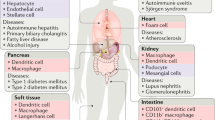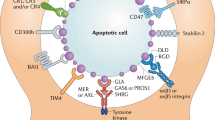Abstract
Definitive erythropoiesis usually occurs in the bone marrow or fetal liver, where erythroblasts are associated with a central macrophage in anatomical units called ‘blood islands’1,2. Late in erythropoiesis, nuclei are expelled from the erythroid precursor cells and engulfed by the macrophages in the blood island2,3. Here we show that the nuclei are engulfed by macrophages only after they are disconnected from reticulocytes, and that phosphatidylserine, which is often used as an ‘eat me’ signal for apoptotic cells, is also used for the engulfment of nuclei expelled from erythroblasts. We investigated the mechanism behind the enucleation and engulfment processes by isolating late-stage erythroblasts from the spleens of phlebotomized mice. When these erythroblasts were cultured, the nuclei protruded spontaneously from the erythroblasts. A weak physical force could disconnect the nuclei from the reticulocytes. The released nuclei contained an undetectable level of ATP, and quickly exposed phosphatidylserine on their surface. Fetal liver macrophages efficiently engulfed the nuclei; masking the phosphatidylserine on the nuclei with the dominant-negative form of milk-fat-globule EGF8 (MFG-E8) prevented this engulfment.
This is a preview of subscription content, access via your institution
Access options
Subscribe to this journal
Receive 51 print issues and online access
$199.00 per year
only $3.90 per issue
Buy this article
- Purchase on Springer Link
- Instant access to full article PDF
Prices may be subject to local taxes which are calculated during checkout




Similar content being viewed by others
References
Bessis, M., Mize, C. & Prenant, M. Erythropoiesis: comparison of in vivo and in vitro amplification. Blood Cells 4, 155–174 (1978)
Sadahira, Y. & Mori, M. Role of the macrophage in erythropoiesis. Pathol. Int. 49, 841–848 (1999)
Kawane, K. et al. Requirement of DNase II for definitive erythropoiesis in the mouse fetal liver. Science 292, 1546–1549 (2001)
Pannacciulli, I. M. et al. Effect of bleeding on in vivo and in vitro colony-forming hemopoietic cells. Acta Haematol. 58, 27–33 (1977)
Zhang, D. et al. An optimized system for studies of EPO-dependent murine pro-erythroblast development. Exp. Hematol. 29, 1278–1288 (2001)
Socolovsky, M. et al. Ineffective erythropoiesis in Stat5a-/-5b-/- mice due to decreased survival of early erythroblasts. Blood 98, 3261–3273 (2001)
Repasky, E. A. & Eckert, B. S. The effect of cytochalasin B on the enucleation of erythroid cells in vitro. Cell Tissue Res. 221, 85–91 (1981)
Wu, H., Liu, X., Jaenisch, R. & Lodish, H. F. Generation of committed erythroid BFU-E and CFU-E progenitors does not require erythropoietin or the erythropoietin receptor. Cell 83, 59–67 (1995)
Broudy, V. C., Lin, N., Brice, M., Nakamoto, B. & Papayannopoulou, T. Erythropoietin receptor characteristics on primary human erythroid cells. Blood 77, 2583–2590 (1991)
Carlile, G. W., Smith, D. H. & Wiedmann, M. Caspase-3 has a nonapoptotic function in erythroid maturation. Blood 103, 4310–4316 (2004)
Zermati, Y. et al. Caspase activation is required for terminal erythroid differentiation. J. Exp. Med. 193, 247–254 (2001)
Fadok, V. A., Bratton, D. L., Frasch, S. C., Warner, M. L. & Henson, P. M. The role of phosphatidylserine in recognition of apoptotic cells by phagocytes. Cell Death Differ. 5, 551–562 (1998)
Balasubramanian, K. & Schroit, A. J. Aminophospholipid asymmetry: A matter of life and death. Annu. Rev. Physiol. 65, 701–734 (2003)
Kawane, K. et al. Impaired thymic development in mouse embryos deficient in apoptotic DNA degradation. Nature Immunol. 4, 138–144 (2003)
Hanayama, R. et al. Identification of a factor that links apoptotic cells to phagocytes. Nature 417, 182–187 (2002)
Hanspal, M. Importance of cell–cell interactions in regulation of erythropoiesis. Curr. Opin. Hematol. 4, 142–147 (1997)
Davies, P. F. Flow-mediated endothelial mechanotransduction. Physiol. Rev. 75, 519–560 (1995)
Schlegel, R. A., Phelps, B. M., Waggoner, A., Terada, L. & Williamson, P. Binding of merocyanine 540 to normal and leukemic erythroid cells. Cell 20, 321–328 (1980)
Geiduschek, J. B. & Singer, S. J. Molecular changes in the membranes of mouse erythroid cells accompanying differentiation. Cell 16, 149–163 (1979)
Strehler, E. E. & Treiman, M. Calcium pumps of plasma membrane and cell interior. Curr. Mol. Med. 4, 323–335 (2004)
Tang, X., Halleck, M. S., Schlegel, R. A. & Williamson, P. A subfamily of P-type ATPases with aminophospholipid transporting activity. Science 272, 1495–1497 (1996)
Zhou, Q. et al. Molecular cloning of human plasma membrane phospholipid scramblase. A protein mediating transbilayer movement of plasma membrane phospholipids. J. Biol. Chem. 272, 18240–18244 (1997)
Zhou, Q., Zhao, J., Wiedmer, T. & Sims, P. J. Normal hemostasis but defective hematopoietic response to growth factors in mice deficient in phospholipid scramblase 1. Blood 99, 4030–4038 (2002)
Williamson, P. & Schlegel, R. A. Hide and seek: the secret identity of the phosphatidylserine receptor. J. Biol. 3, 14 (2004)
Krahling, S., Callahan, M. K., Williamson, P. & Schlegel, R. A. Exposure of phosphatidylserine is a general feature in the phagocytosis of apoptotic lymphocytes by macrophages. Cell Death Differ. 6, 183–189 (1999)
Fadok, V. A. et al. A receptor for phosphatidylserine-specific clearance of apoptotic cells. Nature 405, 85–90 (2000)
Kawasaki, Y., Nakagawa, A., Nagaosa, K., Shiratsuchi, A. & Nakanishi, Y. Phosphatidylserine binding of class B scavenger receptor type I, a phagocytosis receptor of testicular Sertoli cells. J. Biol. Chem. 277, 27559–27566 (2002)
Hanayama, R., Tanaka, M., Miwa, K. & Nagata, S. Expression of developmental endothelial locus-1 in a subset of macrophages for engulfment of apoptotic cells. J. Immunol. 172, 3876–3882 (2004)
Asano, K. et al. Masking of phosphatidylserine inhibits apoptotic cell engulfment and induces autoantibody production in mice. J. Exp. Med. 200, 459–467 (2004)
Takeshita, S., Kaji, K. & Kudo, A. Identification and characterization of the new osteoclast progenitor with macrophage phenotypes being able to differentiate into mature osteoclasts. J. Bone Miner. Res. 15, 1477–1488 (2000)
Acknowledgements
We thank H. Fukuyama for help at the initial stage of this work; H. Suzuki, I. Ito and S. Hanasaki for taking the time-lapse video; T. Yanagida for discussion; and M. Fujii and M. Harayama for secretarial assistance. This work was supported in part by Grants-in-Aid from the Ministry of Education, Science, Sports and Culture in Japan.Author Contributions H.Y. performed most of the experiments. M.K. carried out the electron microscopy analysis, and Y.M. took the time-lapse video. K.K., Y.U. and S.N. contributed to the data analysis. S.N. was responsible for planning the project.
Author information
Authors and Affiliations
Corresponding author
Ethics declarations
Competing interests
Reprints and permissions information is available at npg.nature.com/reprintsandpermissions. The authors declare no competing financial interests.
Supplementary information
Supplementary Video S1
Time-lapse video of the enuclation of an erythroblast. Erythroblasts (1 X 106 cells/ml) were incubated at 37°C in the presence of erythropoietin and transferin. The morphological change of one erythroblast was followed for 3 h, and is reproduced in a 10-s video. (MOV 947 kb)
Supplementary Video S2
Time-lapse video of the engulfment of nuclei by macrophages. Fetal liver macrophages (2 x 104 cells) from DNase II-/- embryos were co-cultured at 37°C with 5 x 105 nuclei isolated from erythroblasts in the absence of 0.5 µg/ml of the D89E mutant of MFG-E8. The engulfment of nuclei by one macrophage was followed for 3 h, and reproduced in a 10-s video. At the end of the incubation, the cells were stained with SYTOX to visualize the engulfed nuclei. (MOV 664 kb)
Supplementary Video S3
Time-lapse videos of the engulfment of nuclei by macrophages. Fetal liver macrophages (2 x 104 cells) from DNase II-/- embryos were co-cultured at 37°C with 5 x 105 nuclei isolated from erythroblasts in the presence of 0.5 µg/ml of the D89E mutant of MFG-E8. The engulfment of nuclei by one macrophage was followed for 3 h, and reproduced in a 10-s video. At the end of the incubation, the cells were stained with SYTOX to visualize the engulfed nuclei. (MOV 637 kb)
Rights and permissions
About this article
Cite this article
Yoshida, H., Kawane, K., Koike, M. et al. Phosphatidylserine-dependent engulfment by macrophages of nuclei from erythroid precursor cells. Nature 437, 754–758 (2005). https://doi.org/10.1038/nature03964
Received:
Accepted:
Issue Date:
DOI: https://doi.org/10.1038/nature03964
This article is cited by
-
Immortalized erythroid cells as a novel frontier for in vitro blood production: current approaches and potential clinical application
Stem Cell Research & Therapy (2023)
-
Recent updates of stem cell-based erythropoiesis
Human Cell (2023)
-
Increased autophagy leads to decreased apoptosis during β-thalassaemic mouse and patient erythropoiesis
Scientific Reports (2022)
-
Induction of enucleation in primary and immortalized erythroid cells
International Journal of Hematology (2022)
-
The path from stem cells to red blood cells
International Journal of Hematology (2022)
Comments
By submitting a comment you agree to abide by our Terms and Community Guidelines. If you find something abusive or that does not comply with our terms or guidelines please flag it as inappropriate.



